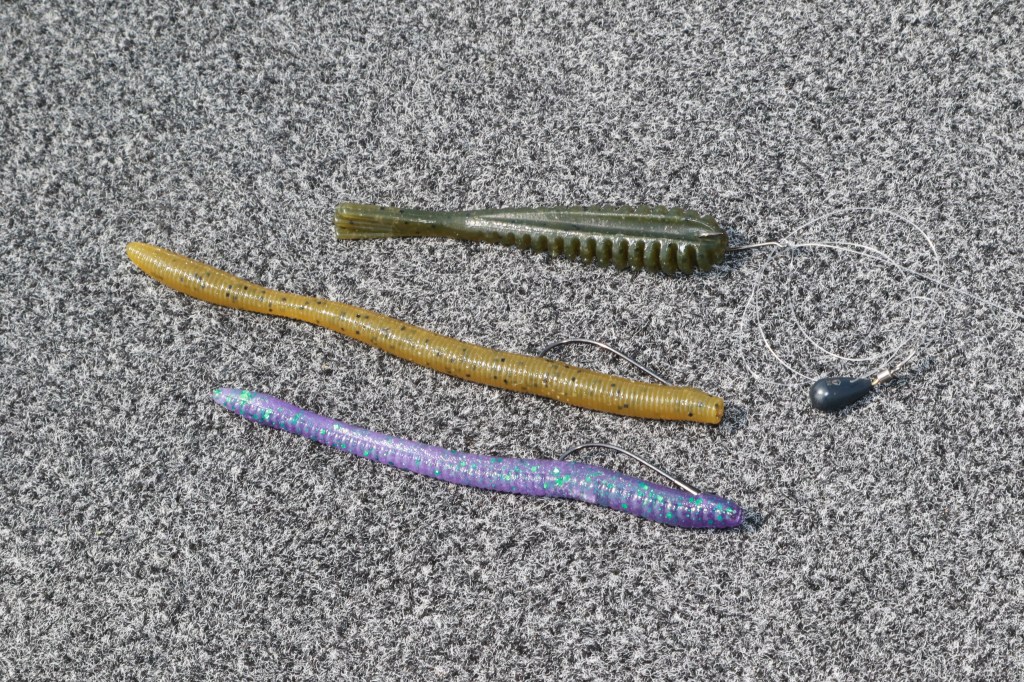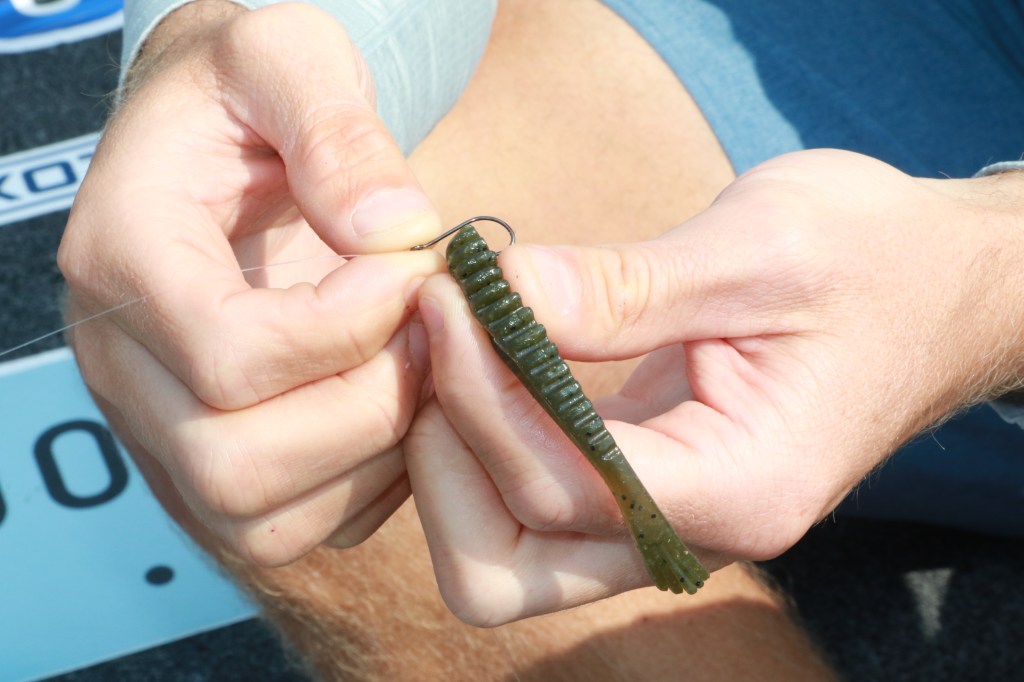
As a primary bait or a follow-up to missed bites and finicky fish, the dropshot is a must-have for anywhere bass swim. Bait shapes are a big part of the bite generating formula, but there’s actually multiple elements that help “shape” your success.
Equally appealing to largemouth, smallmouth, and spotted bass, this versatile finesse rig can close the deal when other baits falter. For starters, let’s look at the basic design.
To a light wire finesse hook like Trokar’s TK150 Drop Shot Hook or Mustad’s AlphaPoint Apex Dropshot Hook, tie a Palomar knot (https://www.berkley-fishing.com/berkley-ae-how-to-tie-a-palomar-knot), but leave an 6- to 18-inch tag end. With the knot secured, pass the tag end through the hook eye, front to back. Pulling the tag end tight rotates the hook outward, so it stands perpendicular to the line.
To the end of this dropper section, affix a dropshot weight — round or bell shape for rock or shell bottom; cylinder style for grass, brush or any snag-prone habitat. With either style, elevating a bait off the bottom and maintaining a constant position tempts fish with a vulnerable meal image and appeals to the ones that don’t feel like moving very fast.
For a simpler method, pre-rigged terminal tackle options like Gamakatsu’s G-Finesse Swivel Shot and VMC’s SpinShot comprise a dropshot hook mounted on a wire stem with tie-off points above and below. Tie your main line leader to the top and add a dropper tied to a weight to the bottom.
The Bass Pro Shops XPS Dropshot Rig offers a beginner-friendly option with a hook mounted on a swivel and a the weight dropper and main line leader already attached.
A few more thought on how to shape up your dropshot game.

Plastic presentation
Bassmaster Elite pro Chad Pipkens said forage and cover typically define his choice of plastics. Keeping it simple, he wants something that imitates a minnow, shiner or other baitfish and a couple of worm options.
Baitfish Forms: Pipkens designed the Perfection Lures Pipkens Drop Shot Bait because to mimics the gobies common to Great Lakes fisheries, as well as juvenile bream. The shorter baitfish forms, he said, also excel on post-front days when lethargic bass may be nipping at longer baits but missing the hook.
Other minnow style baits such as the Big Bite Baits Scentsation Smasher, Missile Baits Bomb Shot, Strike King Dream Shot, and Yamamoto’s Shad Shape Worm represent an array of small baitfish from alewives, to shad. Berkley’s MaxScent Flat Worm (actually a slender baitfish profile) has become one of the most popular dropshot baits for northern smallmouth.
Worms: Modest finesse worms, generally with straight tail models like the classic Roboworm, Zoom Z-Drop, or Z-Man Finesse WormZ work best. No need for curly, ribbon or paddle tail worms, as the dropshot is mostly fished in static or slow dragging presentations that lack the motion needed to maximize an active tail design.
“The finesse worm is good for working through brush and grass, where a baitfish shape tends to get hung up more often,” Pipkens said.
Calling the 6-inch Perfection Lures David Dudley Finesse Worm his go-to, Pipkens said the bait’s super soft composition puts on a tempting display that fish can’t resist.
“When the fish are biting, that bait just looks good in the water even if you do nothing but drag it,” Pipkens said. “But maybe the fish want a little motion; you can get that bait to do a lot.”
At times, the fish seem to like a supple bait’s enticing wiggle, but they’re not grabbing the entire worm. When this happens, Pipkens switches to a 4-inch finesse worm to coax fish closer to the hook.
In this scenario, some opt for Senko style “stick” worms for their thicker bodies and more substantial profiles. The smaller 3-inch stick worms have less motion than thinner finesse worms, but they do a good job of imitating a slender baitfish.
Other Bait Options: Craw baits can be highly effective when you need a bolder profile to stand out near hydrilla edges, reeds, etc. Craws are particularly effective during winter and early spring, when fewer baitfish put an emphasis on the mud bugs.
The Missile Baits Fuse, created by Bassmaster Elite John Crews blends a finesse worm form with subtle pinchers.
Small creature baits, leeches, and the unique whiskered style baits like the OSP Saikoro “Dice” can deliver big results when the bite is tough.
Super Sized: While the basic dropshot concept is synonymous with finesse, an upsized version known as the power-shot, or “Bubba-shot” allows for presentations into denser areas where the traditional light line finesse rig simply would not survive. Increasing line, hook, and bait size — often full-sized stick worms, magnum trick worms — gives fish that elevated look with components that can effectively enter and exit rougher neighborhoods.
Elite veteran Greg Hackney occasionally will use a stouter dropshot to present baits like the Strike King Rage Bug or Game Hog around shallow cover.
“Typically, that’s a spawning deal; blind fishing for spawners I can’t see,” Hack said.

Hooked on plastics
Nose hooking is most common for dropshots, as the minimalist placement allows nearly the entire bait complete freedom of motion. Insert the hook into the bait’s underside about 1/4- to 1/3 inch back from the bait’s nose and bring it out the top so the bait rides in the hook bend.
If you’re having trouble with hook sets, try adjusting your nose hooking method by bringing the hook only halfway into the bait and exiting the point right through the nose. This minimizes the amount of plastic in the hook bend and often leads to more efficient hook sets.
Threaded: If he’s missing a lot of bites, especially during the spawn when fish are usually more interested in removing bed intruders than actually eating them, Pipkens will thread his dropshot bait onto a 1/0-2/0 Roboworm Rebarb hook.
“When you hook them on that, it gets deeper in their mouth,” Pipkens said.
Texas Rigged: Taking the threaded bait premise a step farther, Texas rigging hides the hook point for a weedless presentation. With a longer shank finesse flipping style hook, run the point into the bait’s nose just past the barb, push the point out the side of the bait, then pull the hook through the bait until the eye rests at the bait’s nose.
Now, rotate the hook so the point faces the bait. Hold the hook and bait together, bend the bait forward about 1/4 inch, run the hook point through the bait, then allow the bait to resettle for a perfectly straight weedless alignment.
Wacky: Impaling a finesse or stick worm roughly mid-body makes both ends wiggle. This creates a different look that contrasts the standard perpendicular dropshot bait posture. When the bite is tough, such variance might earn you another look or two.
Gilly: A unique option promoted by the late Aaron Martens, arguably the most brilliant finesse technician to ever spool a reel, the Gilly style runs the hook sideways through the bait’s head, as if it were set through the gills of a baitfish. Again, it’s simply a different look that might make that bait stand out just enough to trigger a picky fish.
Keep it close
Closing with a safety/organizational tip, most anglers know that securing an open hook in a rod keeper or a guide’s frame is standard procedure; but you have to consider the potential hazard’s of a dropshot’s weigh-dangling design. During boat rides or general tackle storage, an unsecured weight can potentially cause rod damage, while any free-swinging terminal tackle risks entanglements.
Rods made specifically for dropshot duty typically include weight keepers that allow you to control the entire rig between uses. Lacking such features, rubber bands, twist ties, pipe cleaners and even hair scrunchies accomplish the task.





